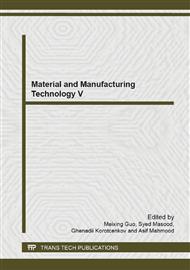p.141
p.147
p.152
p.157
p.162
p.169
p.174
p.179
p.183
Surface Alloying of Copper Substrate Coated by Fe-Si by Using CO2 Laser
Abstract:
Advanced industrial applications require materials with special surface properties such as high hardness and high wear resistance. In this study, copper substrate samples where coated by Fe-Si by using thermal evaporation technique under high vacuum, then subjected to surface laser treatment by using 720 watt CO2 laser beam. The purpose was to perform local alloying in the form of surface network of four tracks (each two are parallel and perpendicular to the other two) to produce a good thermal and electrical properties bulk material with reasonable surface hardness properties. The morphological features of the subsurface laser treated layers and their mechanical properties (microhardness) have been studied on oblique sections through the laser fused tracks. The results show that there were an intensive re-evaporation of the coating material, probably because of the high laser power density applied and the use of deep vacuum during the laser surface alloying process. Generally hardness recorded to be increased in the laser-fused tracks locations, but the bottom of the laser fused tracks showed a number of spherical voids causing a drastic decrease in the hardness values. The middle parts of the tracks showed columnar structure and elevated hardness values.
Info:
Periodical:
Pages:
162-168
Citation:
Online since:
June 2014
Authors:
Price:
Сopyright:
© 2014 Trans Tech Publications Ltd. All Rights Reserved
Share:
Citation:


